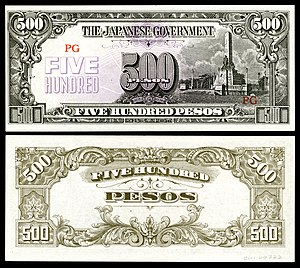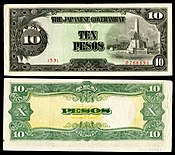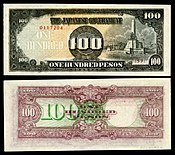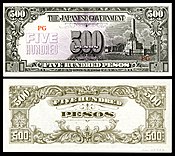Japanese government–issued Philippine peso
| Peso Template:Language icon and Template:Language icon, Piso Template:Language icon | |
|---|---|
 Obverse and reverse of the 500 pesos note, 1944-1945 | |
| Unit | |
| Plural | pesos |
| Symbol | ₱ |
| Denominations | |
| Subunit | |
| 1/100 | Cent Centavo or Céntimo (Spanish) Sentimo (Filipino) |
| Banknotes | 1₱, 5₱, 10₱, 100₱, 500₱, 1000₱ |
| Demographics | |
| User(s) | |
| Issuance | |
| Central bank | Japanese government |
During World War II in the Philippines, the occupying Japanese government-issued fiat currency in several denominations; this is known as the Japanese government-issued Philippine fiat peso (see also Japanese invasion money). The puppet state under José P. Laurel outlawed possession of guerrilla currency, and declared a monopoly on the issuance of money, so that anyone found to possess guerrilla notes could be arrested.
Some Filipinos called the fiat peso "Mickey Mouse money". Many survivors of the war [who?] tell stories of going to the market laden with suitcases or "bayóng" (native bags made of woven coconut or buri leaf strips) overflowing with the Japanese-issued bills. According to one witness, 75 "Mickey Mouse" pesos, or about 35 U.S. dollars at that time, could buy one duck egg.[1] In 1944, a box of matches cost more than 100 Mickey Mouse pesos.[2]
These bills were often used by American psychological warfare personnel as propaganda leaflets. Japanese occupation banknotes were overprinted with the words "The Co-prosperity Sphere: What is it worth?", in an attempt to discredit the Greater East Asia Co-Prosperity Sphere, and dropped from Allied aircraft over the occupied territories.[3]
Denominations
1942 series
1943–45 series
A new series of 1, 5, and 10 peso bills was issued in 1943. Hyperinflation had also forced the Japanese to issue 100, 500, and 1000 peso notes in 1944.
See also
- Emergency circulating notes
- Japanese government-issued dollar in Malaya, North Borneo, Sarawak and Brunei
- Philippine peso
References
- ^ Barbara A. Noe (August 7, 2005). "A Return to Wartime Philippines". Los Angeles Times. Archived from the original on February 17, 2009. Retrieved 2006-11-16.
{{cite news}}: Unknown parameter|deadurl=ignored (|url-status=suggested) (help) - ^ Agoncillo, Teodoro A. & Guerrero, Milagros C., History of the Filipino People, 1986, R.P. Garcia Publishing Company, Quezon City, Philippines
- ^ Friedman, Herbert A. "WWII Allied Propaganda Banknotes". Retrieved 2010-04-17.













